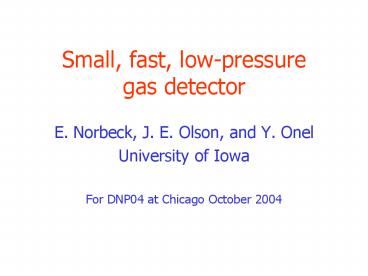Small, fast, lowpressure gas detector - PowerPoint PPT Presentation
1 / 17
Title:
Small, fast, lowpressure gas detector
Description:
Filled with 10-80 torr isobutane. 500-1000 V between plates (Parallel Plate Avalanche Counter) ... is isobutane at 10 to 100 torr. E. Norbeck U. Iowa. DNP04 BB. ... – PowerPoint PPT presentation
Number of Views:54
Avg rating:3.0/5.0
Title: Small, fast, lowpressure gas detector
1
Small, fast, low-pressure gas detector
- E. Norbeck, J. E. Olson, and Y. Onel
- University of Iowa
- For DNP04 at Chicago October 2004
2
Typical low-pressure PPAC
(Parallel Plate Avalanche Counter)
- Two flat plates
- Separated by1-3 mm
- Filled with 10-80 torr isobutane
- 500-1000 V between plates
3
Small PPAC for showers from high-energy (10-1000
GeV) electrons
- The original object of this study was to
determine the suitability of a PPAC as an
inexpensive, very fast, rad-hard pixel detector
to use in a calorimeter for electrons. - Our measurements have broader application.
4
Single Pixel PPAC For Test With High-Energy
Electrons
- Gap 1.0 mm
- Cathode 7X0 29 mm of tantalum
- Area of anode is 1.0 cm2
- Guard ring to simulate neighboring pixels
- Gas is isobutane at 10 to 100 torr
5
Detail of 1 mm gap and guard ring
6
- A MIP will usually leave no ionization in the low
pressure gas. With a high-energy electron shower
there are 100s or 1000s of electrons contributing
to the signal. - To date we have not yet put a high-energy
electron into the detector. - Our measurements have all been with Compton
electrons from a 137Cs gamma source. With the
source to the side of the PPAC, a few of the
electrons travel parallel to the face of the
plates and produce a usable amount of ionization
in the gas.
7
Electron signal
Single peak with considerable noise. The noise is
large because of the small size of the signal
using our 137Cs source. With the much larger
signals from high-energy electrons, the noise
will be negligible.
8
For high speed, the RC time constant must be kept
small. Only PPACs of small area are fast 1 ns R
50 O (coax cable). C is the capacity between
the plates C .885 pF for 1 mm gap and area of
1 cm2 For our larger PPAC with C 168 pF
rise time 5 ns fall time 7 nsFast enough
for a Zero Degree Calorimeter at the LHC
where minimum beam crossing time is 25 ns.
9
Ion collection time
10
Reflections are a problem with such fast
signals. Should be 50 O all the way to the anode.
Guard ring
View with covers removed
Signal out
11
At isobutane pressures less than 30 torr
afterpulses sometimes occur during the first 20
ns. This is a worst case example. Total charge
from the afterpulses can be much larger than
primary signal.
10 torr 500 V
12
The afterpulses seen here are usually hidden
inside of signals that are more than 20 ns wide.
This may be the cause of the typically bad energy
resolution of PPACs operated in the 5 to 20 torr
range.
What causes the afterpulses?
They are most likely caused by UV photons
producing photoelectrons at the cathode. These
electrons then initiate a new avalanche.
Changing the anode from stainless steel to
graphite had no effect on the afterpulses. This
shows that the photons do not come from the
anode.
13
Perhaps the excited molecules emit photons with a
lifetime long compared with 20 ns, with molecular
collisions limiting the lifetime of the
excitations. Collision time in isobutane gas is
too long to account for the data. Isobutane
speed 350 m/sFragments are fasterIon speed gt
2000 m/s (1 mm in 500 ns)
Note also that electrons acquire a larger energy
between collisions at the lower gas pressures.
500 V at 10 torr but 1000V at 80 torr
14
Ion current from same event Afterpulses are real
avalanches
15
The area under the ion peak is clearly larger
than the area under the electron peak. The
signal is caused by the motion of the charges in
the 1 mm gap (not by the collection of the
charges). Most of the charges generated by the
avalanche are produced close to the anode so that
electrons move only a short distance, while the
ion move almost the entire millimeter. Signal
processing can easily remove the slow ion peak
form the signal.
16
PPAC can be made resistant to radiation damage
- The walls and electrodes can be made of durable
metal in high-energy applications. - A single spark can make a sharp point on the
metallic surface of the cathode that will make
the PPAC inoperable. The energy carried by a
spark must be kept small, and provision must be
made to keep sparking to a minimum. - Aging (polymerizing of the gas) must be
prevented. (Low pressures and short distances
require special considerations.)
17
Conclusions
- Small area PPACs can be made to be radhard and
fast ns. - PPACs have been used for 30 years, but more
research is still needed maximize their
potential.































